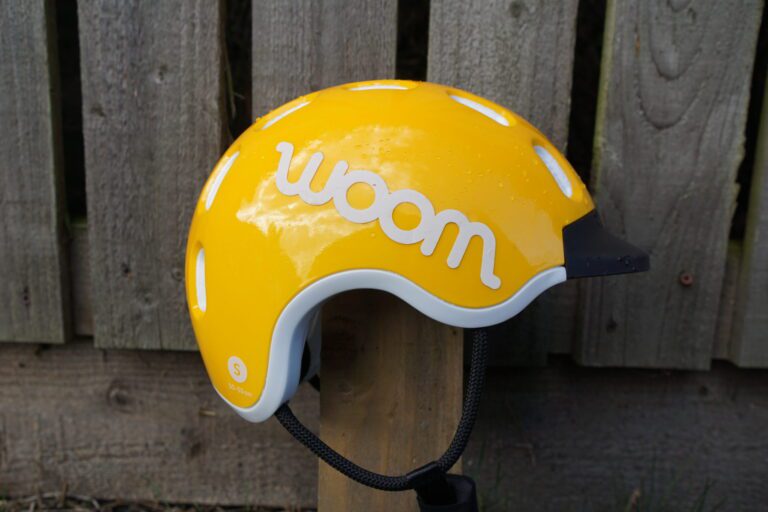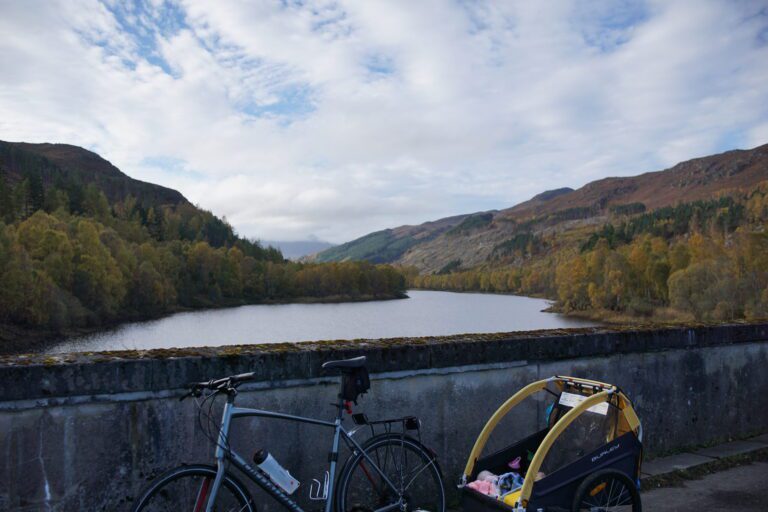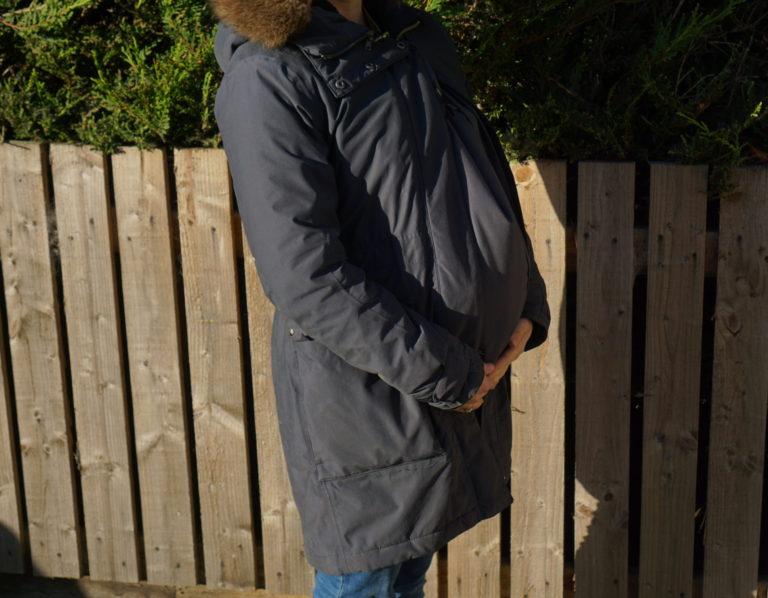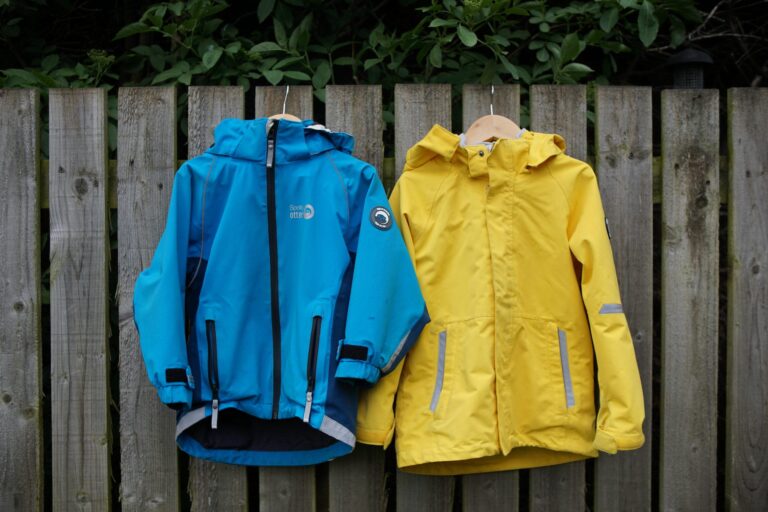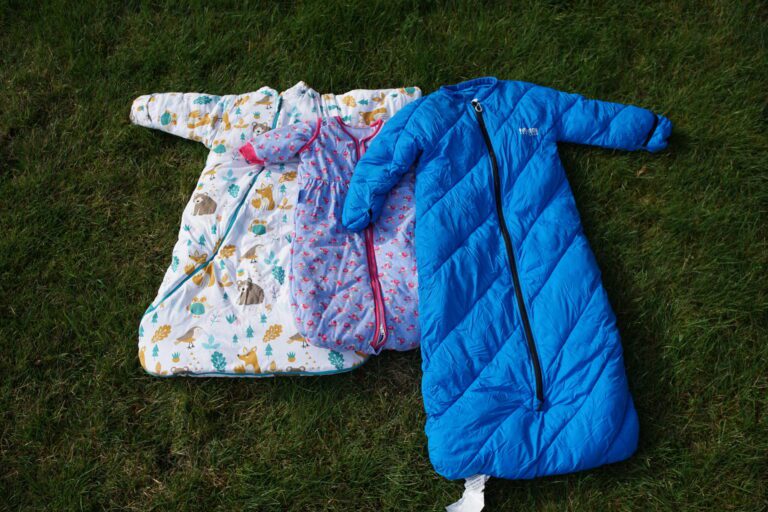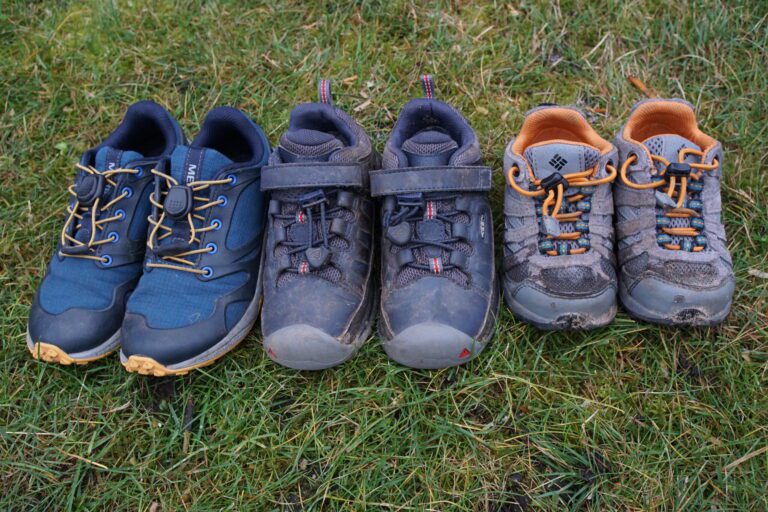Long Term Use Review: Thule Chariot Cross 2
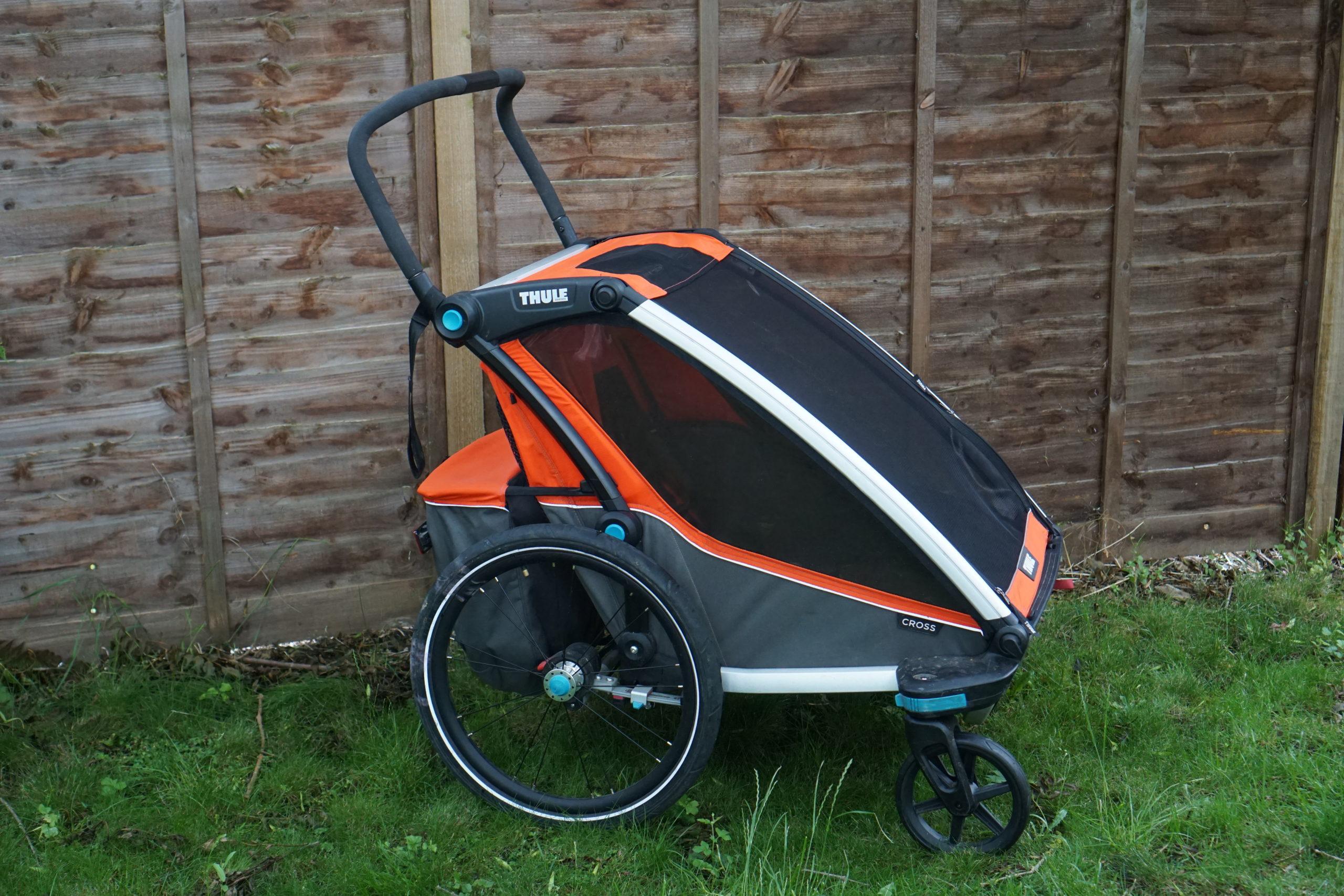
This post contains affiliate links. As an Amazon Associate I earn from qualifying purchases.
The Cross is the top of Thule’s range of multi-sport trailers. It offers options for walking, jogging, cycling, and even skiing! We have owned our Thule Chariot Cross 2 for several years, and have grown to love it more over that period. We use it for daily cycling around town, jogging and some cycle touring.
We own the 2019 model, with the upgraded ventilation. Read on to discover what we think about whether this works!
Some aspects of the review are easier to explain visually, so I’ve also created an accompanying video with timestamps, so you can skip to the part you are interested in.
Now on to the review! First up, a summary of what we like and dislike about the trailer:
Pros
- Sturdy rugged components
- Excellent handling
- Quality 5 point harnesses
- Individual recline features
- Easy zip down mesh screen
- Luggage boot
- Storage pockets
- Sunshade
- Suspension
- Good visibility for the children
- Excellent infant hammock for babies
- Compact fold – easy to take in the car
Cons
- Rain cover poorly designed for frequent use
- Poor ventilation
- Hitch rubber inflexible
- Switching between modes can be fiddly
- Hard to lock up
Thule Chariot Cross build quality
The build quality is superb, as you would expect for such a high end piece of equipment. We have used the trailer extensively for over three years, and there is barely a mark on it. Our previously bike trailer was also a Chariot and was still going strong after over a decade.
The trailer has many useful features including adjustable handle height, a pocket for each child to put snacks and toys in, and a zip down mesh screen to protect from debris.
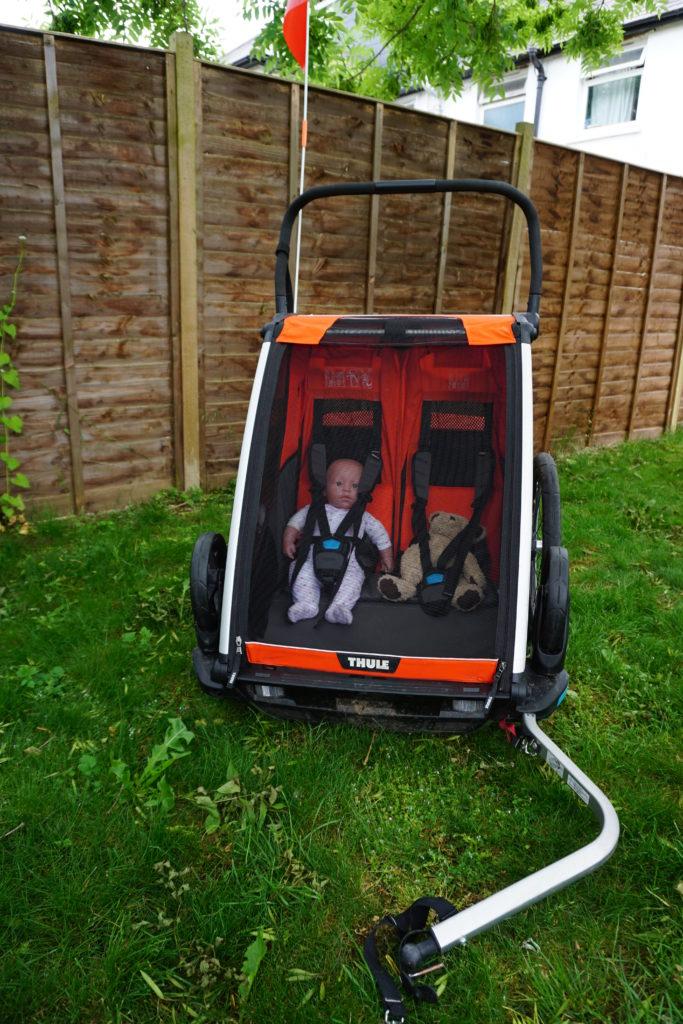
We really really like the harnesses. They are comfortable, easy to adjust, and feel safe and secure. Each side of the five point harness attaches separately, which is especially useful when buckling in two wiggly children in winter gear!
The seats have mesh panels behind the head area which improves ventilation, and also provides some much needed flex for helmets.
The trailer has 20″ wheels which take Schrader inner tubes. We have had a couple of punctures, and I would definitely recommend sourcing a couple of spares to take if you are touring or out for a long ride.
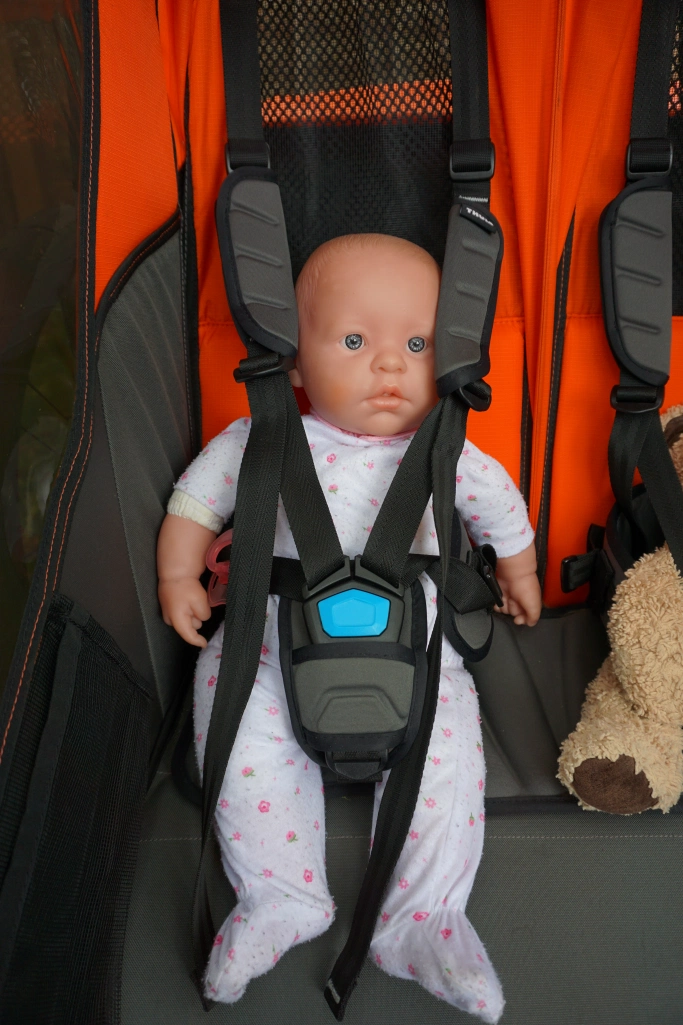
Thule Chariot Cross 2 Dimensions
Different trailers can have quite different dimensions, so I would recommend measuring your own children and considering your specific needs before purchasing. The Thule has a very long rise, 68cm according to Thule, though I measured ours at more like 66cm. It is much taller than the Burley Cub X which has a seat height of 57.2cm.
However, the Thule Cross is narrower than the Burley Cub X, particularly at shoulder height. This makes a noticeable difference when children are wearing bulky winter clothing. It is quite a squeeze to get two toddlers in winter waterproofs into the Cross.
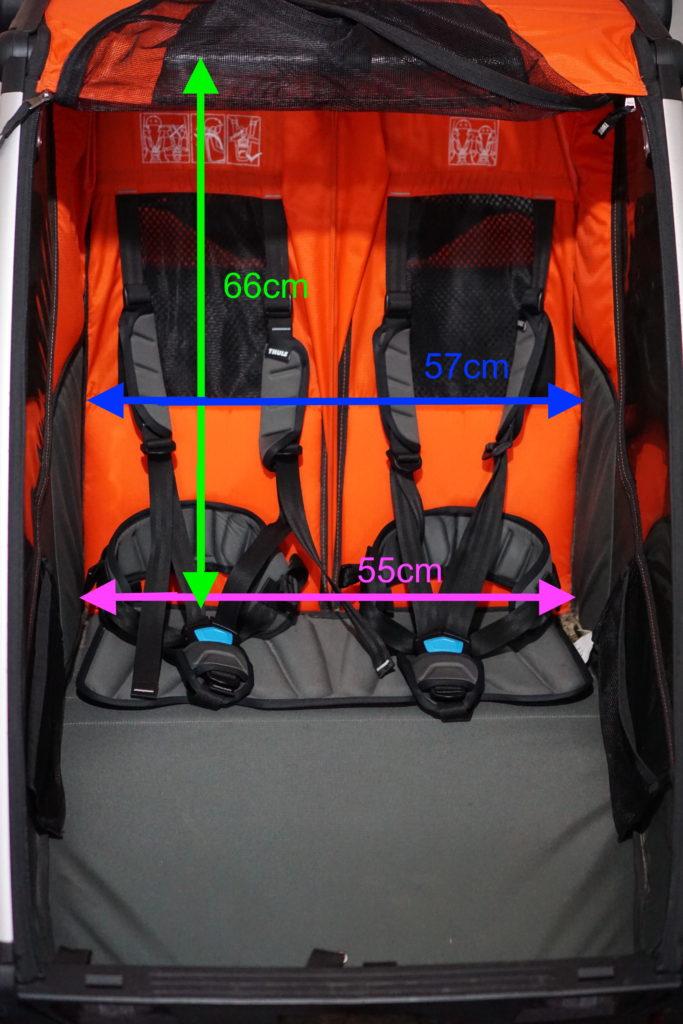
Using the Thule Chariot Cross 2 as a Bike Trailer
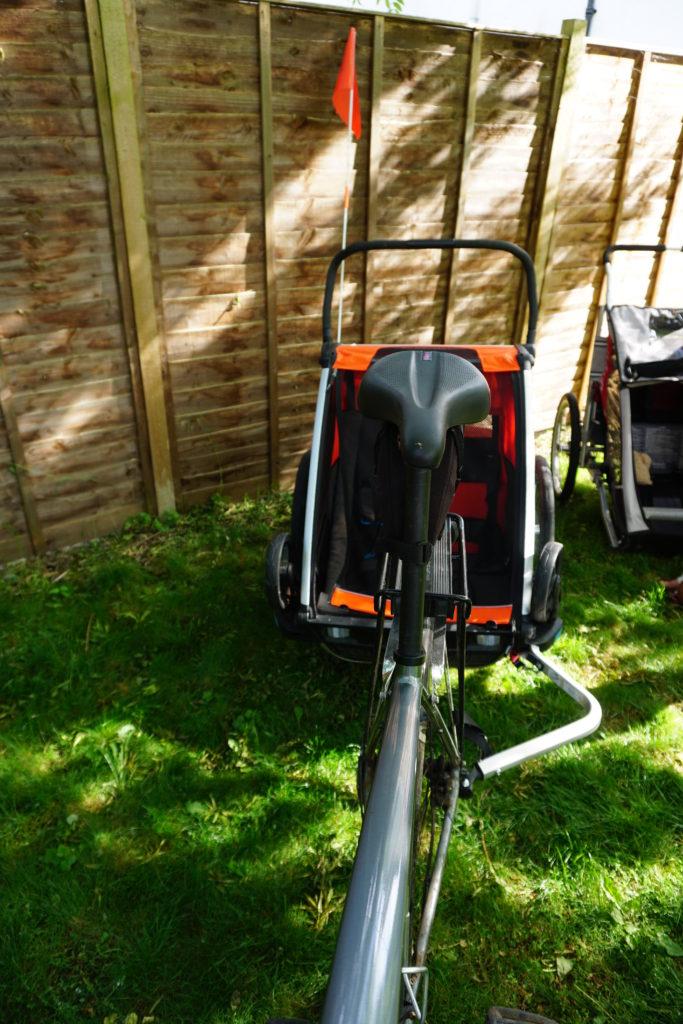
The bike attachment has a ball joint, meaning that it pulls very smoothly. One feature that I really like about the Thule trailer is that the hitch centres the trailer on the bike. This means that when you go through a narrow gap, all too common on UK cycle routes, you just need to direct your bike straight down the middle of the gap, and if there is room, the trailer will follow.
In contrast, Burley trailers are slightly off-centre. This can be useful for positioning the trailer safely inside the bike when in traffic. However, having tried out a Burley trailer on holiday, we found that we kept bumping the trailer against bollards because of the off-centre design. I suspect this is something you get used to.
The cup of the ball joint attaches to the bike easily using an extra-long axle skewer (supplied). There is a pin and rubber strap to secure the ball joint in place. On our trailer the pin is a tight fit through the holes, and the rubber on our trailer is really quite hard work to pull into place over the pin. For me this is usually a two handed job with the bike held up on its stand. With our old trailer everything was a bit more flexible and I could do it one-handed. My husband finds it easier, so I think it is down to hand strength. A minor thing perhaps, but the difficulty frustrates me every single time I hitch or unhitch the trailer.
There is also a canvas safety strap which you are supposed to clip onto the bicycle stay. In my view this is poorly designed; the strap is not long enough to reach around the stay on two of our bikes, so we have to use the (much feebler) mudguard stay. Also, the beginning of the strap and the ‘eye’ are on the far side of the hitch arm, making it difficult to manoeuvre the clasp into place. On our old bike trailer, the beginning and end of the strap were above and below the hitch arm, which made access much easier.

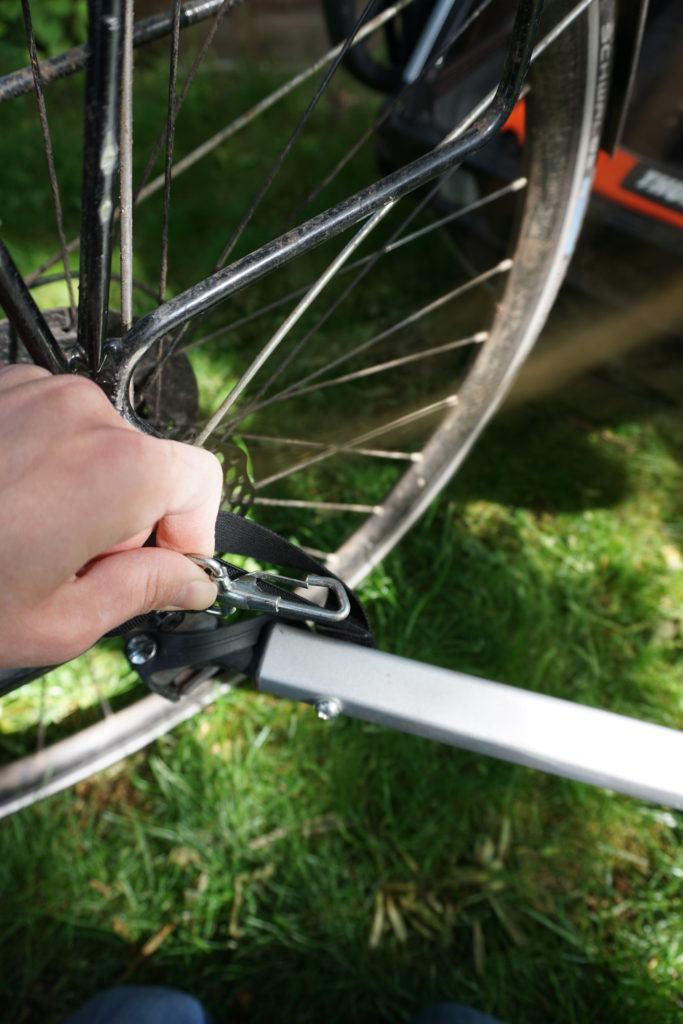

One other point to note is that there is no easy point for securing a bike lock to the trailer. We use a long cable secured around one of the rear metal posts of the roll cage. On our old trailer, there was a bar across the front at the bottom which made it much easier to use a short lock attached to the main D lock through the bike’s frame.
Using the Thule Chariot Cross 2 in rain and sun
The trailer comes with a rain cover and a sunshade. I find the sunshade extremely useful in the summer, especially when touring. It makes for a much more comfortable environment inside, especially for babies. Of course, there can be problems with older children wanting to be able to see out! We have found that a good compromise is to position the sunshield folded over (see photo). This provides a reasonable amount of protection and visibility.


The rain cover was one of my main hesitations when purchasing the Cross. The rain cover is designed to be totally taut – I think this is in order to improve visibility. In order to achieve that tautness, it is a real stretch to get it into place.
The rain cover uses six elastic loops to attach to hooks around the edges of the bike trailer. It is very hard work to stretch the last two loops into place at the bottom (see photo). In the cold wet weather I find it extremely annoying having to undo and redo this fastening with frozen fingers every time I want to check on the baby or pass a toddler a toy they’ve dropped. Realistically, in British weather the rain cover needs to be in place for much of the winter, whether it is raining or not. in my view it isn’t fit for purpose.
In winter we now store the raincover attached to the trailer by its top four loops and folded under (see photo), and so we only have to attach the final two loops when we want to put it on. This cuts down on the work, but you do still need to dismount your bike and prop it up in order to open or close the rain cover. With our old trailer the rain cover was attached with velcro, and I could just lean over from the saddle to lift it up or down.
One thing I would say is that the rain cover is highly effective. We have toured all day in the rain with this trailer, and whilst the rest of us were soaked, the children inside stayed warm and dry.
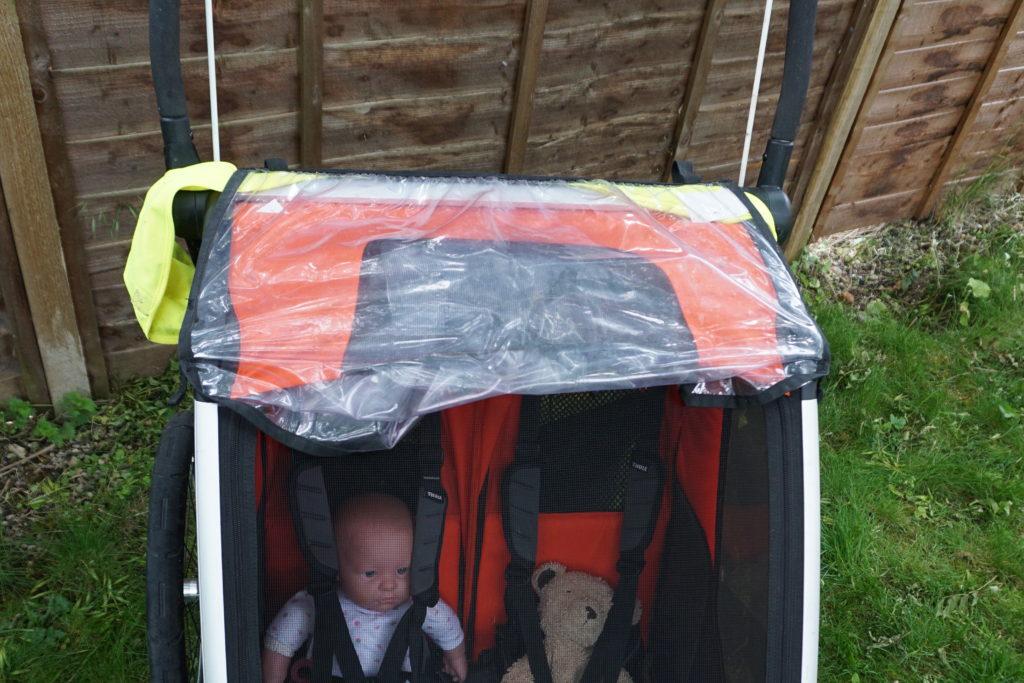

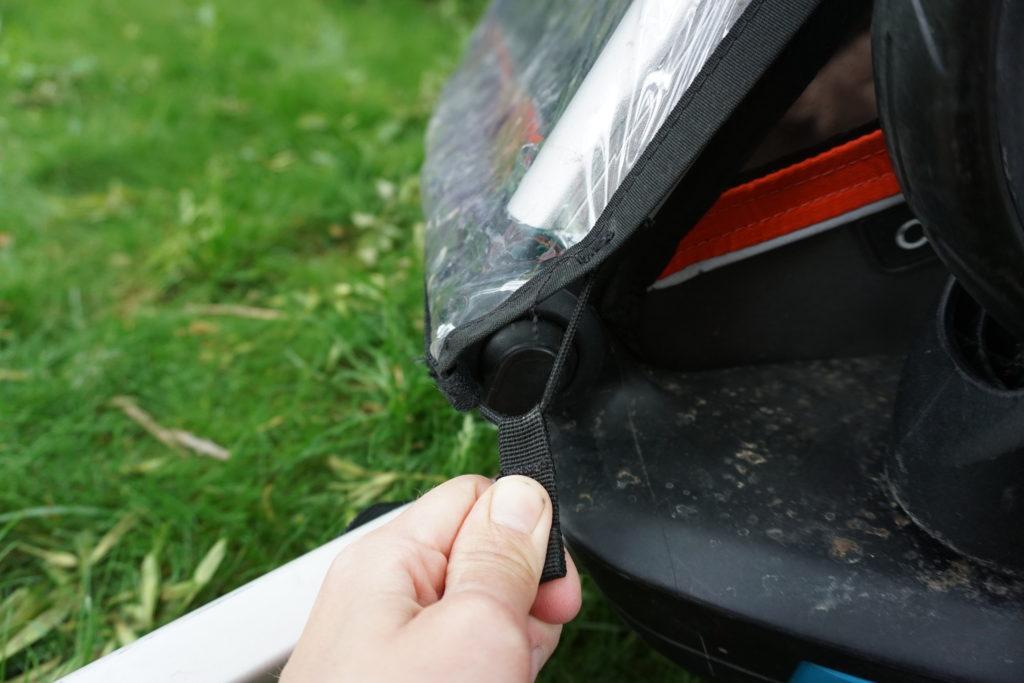
The Cross received an update in 2019 to improve ventilation, as the rain cover is so taut that there is very little airflow when it is in place. There are new air vents at the bottom front, and also six small clips which can attach around the sides to slightly lift the rain cover and allow ventilation through the sides.
We haven’t used the six clips; it is already time consuming enough to attach the rain cover without fiddling around with six extra clips. They feel very much like a sticking plaster rather than a solution.
The front air vents are easy to use. We do still find that the rain cover steams up within half an hour or so in warm wet weather. The children don’t seem too bothered.
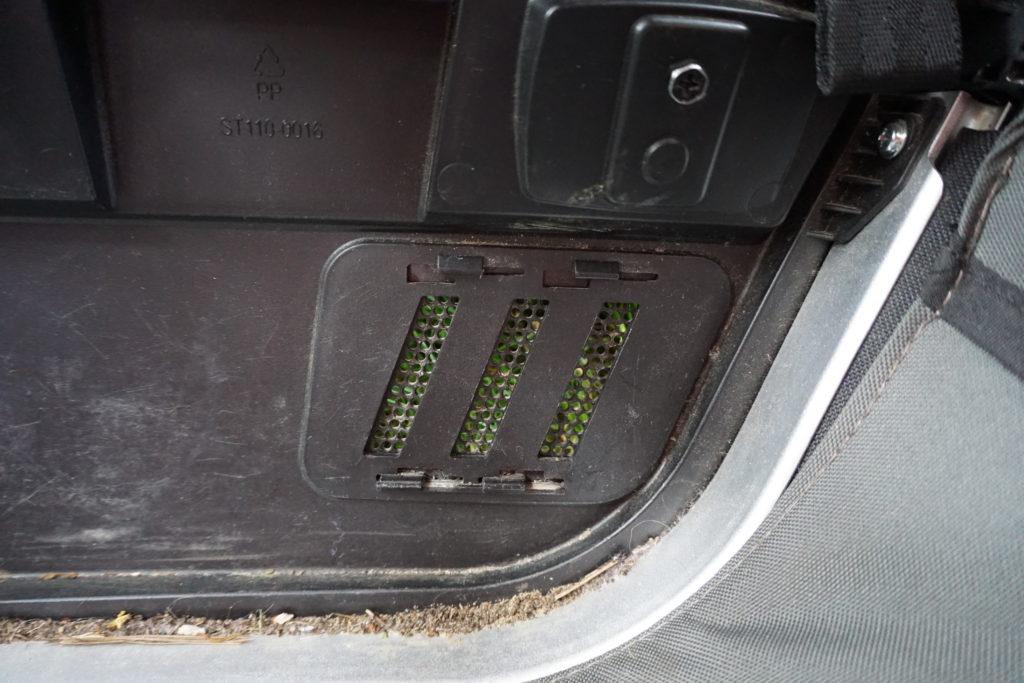
Visibility: Using the Thule Chariot Cross 2 on the Road



The Cross comes with rear reflectors, and the bright orange colour is pretty visible. However, we use ours predominantly on busy city streets, and in the winter it can be in low light conditions. We therefore made some modifications to make ourselves more visible, adding an extra flag and some high vis. This creates some drag in windy conditions, and I sometimes wish there had been an option with more reflective panels etc. However I accept that not everyone will want to be as visible as us!
Storage in the trailer
The Cross has a luggage ‘trunk’ at the rear, which is pretty capacious. You can fit a big changing bag in there with several coats as well. We can take this to the park in summer with changing bag, swim-gear, snacks, buckets and spades. However, Thule have stated a 4kg weight limit for the contents of the luggage trunk. This seems ridiculously low to me, as it is very sturdy, and I can only assume it is to do with the balance of the trailer. We do put more weight than 4kg in here, but if I am doing the grocery shopping I will try to put something light and bulky in here (e.g. nappies) rather than milk bottles.
The trunk clips up out of the way to provide extra legroom for the person pushing, which you do need to do if jogging. It is worth noting that you cannot use the recline feature when the luggage trunk is clipped up.
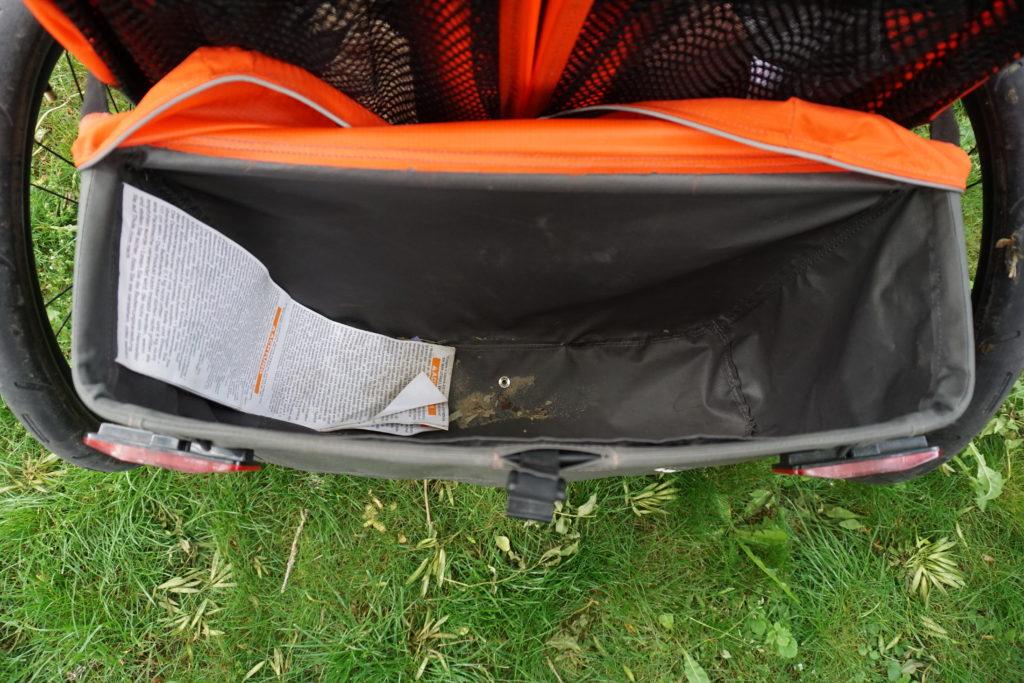
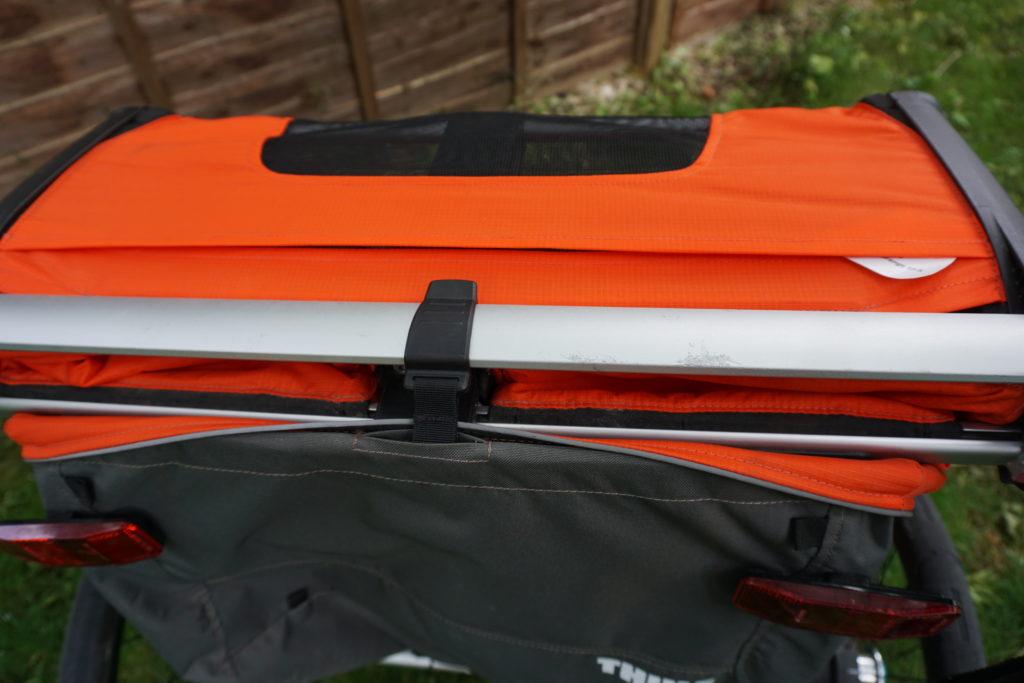

Recline Mode
The Cross has an individual recline feature for each seat. You simply squeeze the handle and pull back; there are two options for level of recline. This is one of my favourite features of the Cross, and a complete game-changer for touring. With most trailers, I find that if a child falls asleep (which they naturally do with the motion), they tend to loll about all over the place looking very uncomfortable. We stop cycling to prop them up on coats and bags, which fall down when we next go over a bump, and then we do the whole thing again. Or, the child sleeps on their sibling’s shoulder which is annoying for them. Now, as soon as they fall asleep, I can just lean the seat back for them to sleep comfortably.
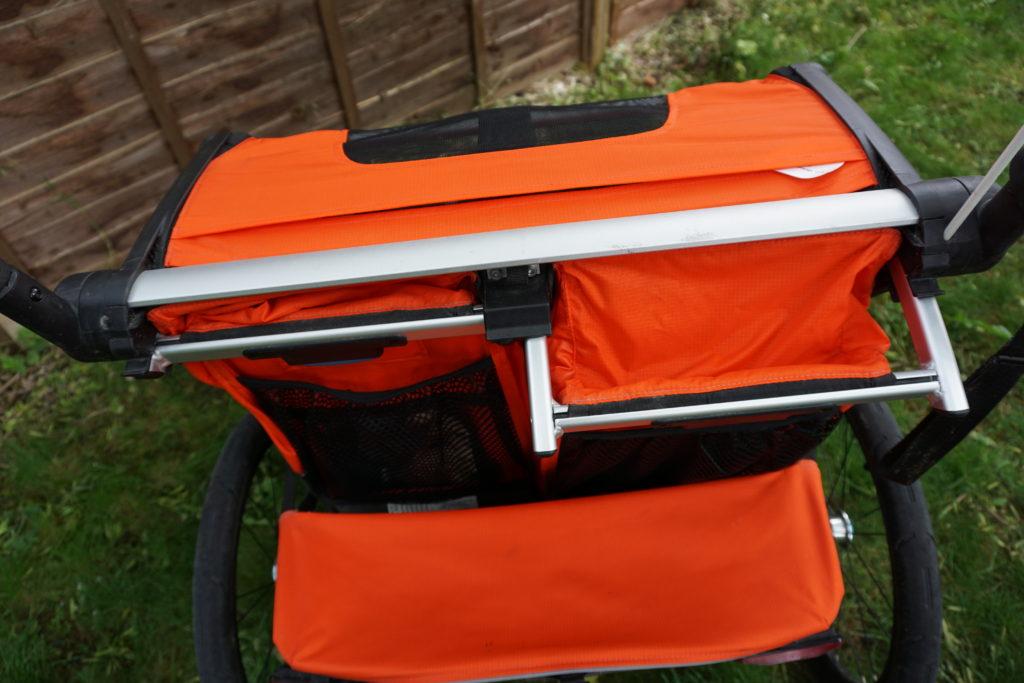

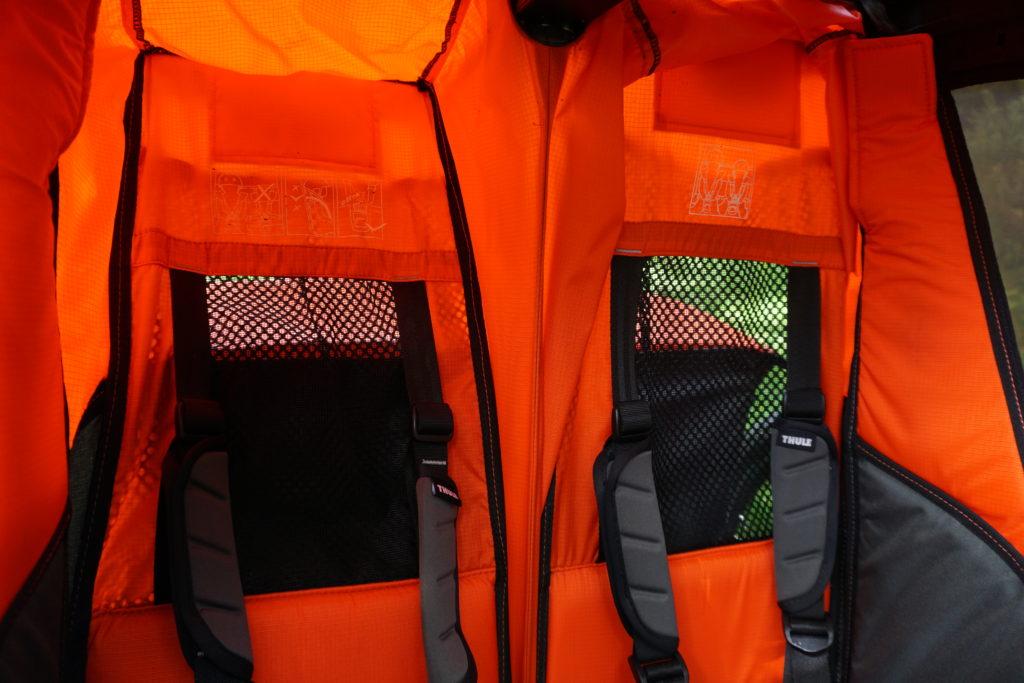
Thule Chariot Cross Baby Insert
Thule offer two baby accessory options which you can purchase separately. There is the infant sling for babies aged 1-10 months and the baby supporter for babies aged 6-18 months.
We have the infant sling, which is brilliant. It attaches securely to the trailer with six metal hooks, and provides additional suspension to help cushion your little one. The upper age and weight limit feel about right in our experience.
We have chosen not to purchase the baby supporter, as we had a previous version with our old trailer and didn’t feel that it functioned very well. If we have a baby in the trailer there is always a second child in there too, and that prevents them from slipping sideways. If you will be travelling with only one small child in the trailer, then the baby supporter could be very helpful.
Thule explicitly state that you should not use the infant sling for cycling. Indeed, they state that you should not use the trailer for cycling at all with children under one. It isn’t the purpose of this review to debate at what age children should go on a bike, but suffice to say that after careful consideration we use the infant sling with our children whilst cycling, from approximately 4 months onwards, or when they have decent head control.
One minor gripe I have with the infant sling is that the angle of recline is fairly steep. This is completely fine with the stroller wheels on, or when attached to the bike. However, if you have the front of the trailer just resting down on the ground whilst getting ready, then the angle of the sling is really quite steep, and I feel that too much of the baby’s weight rests on the crotch strap. Fine for a few seconds, but I wouldn’t want to leave them like that for long.


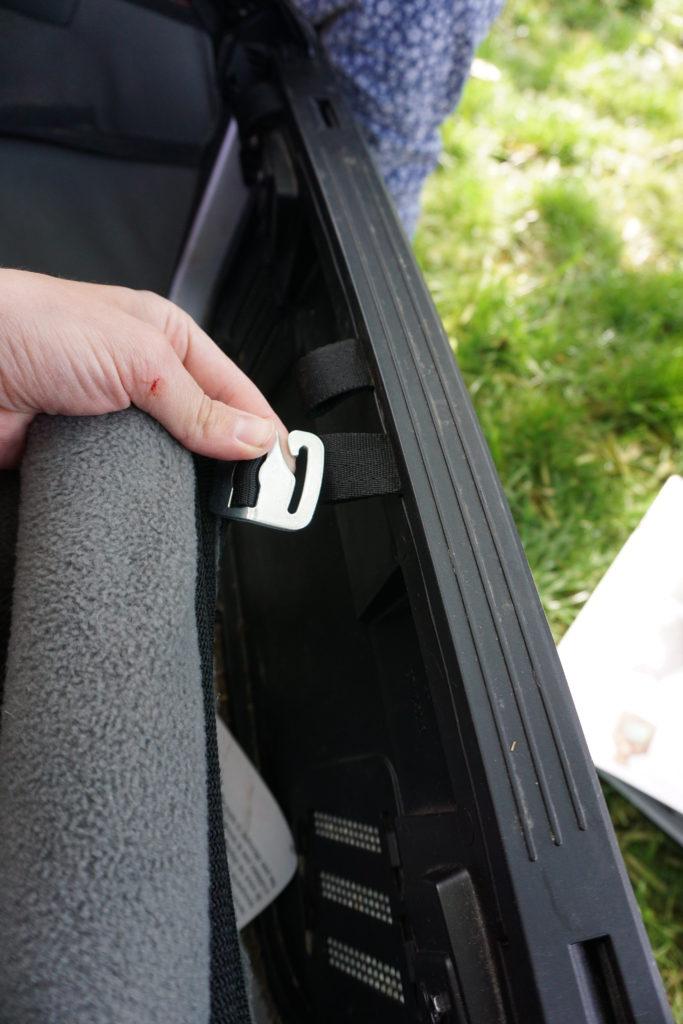
Switching between different modes: Walk, Cycle and Run
The Cross uses Thule’s VersaWing technology to switch between different modes. Essentially, there are different attachments which clip in at the bottom front depending on whether you wish to walk, jog, cycle or ski.
To change mode, you pull the blue clip out to release the current attachment, remove the attachment, slot in the new attachment and close the clip. The orange colour inside the clip helpfully alerts you that the clip is open and attachments are loose. Buggy wheels can be stored on top of the VersaWing when not in use. The bike arm can be stored down the side of the trailer which is handy; when doing this it helps to clip the two straps together so that they don’t drag on the ground (see photo).
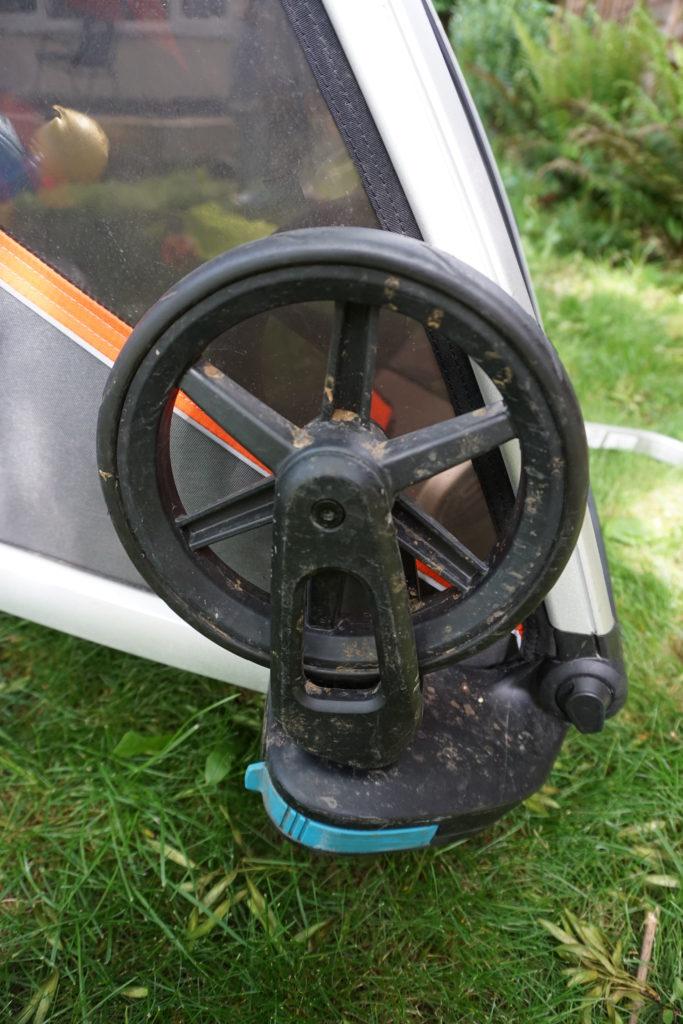


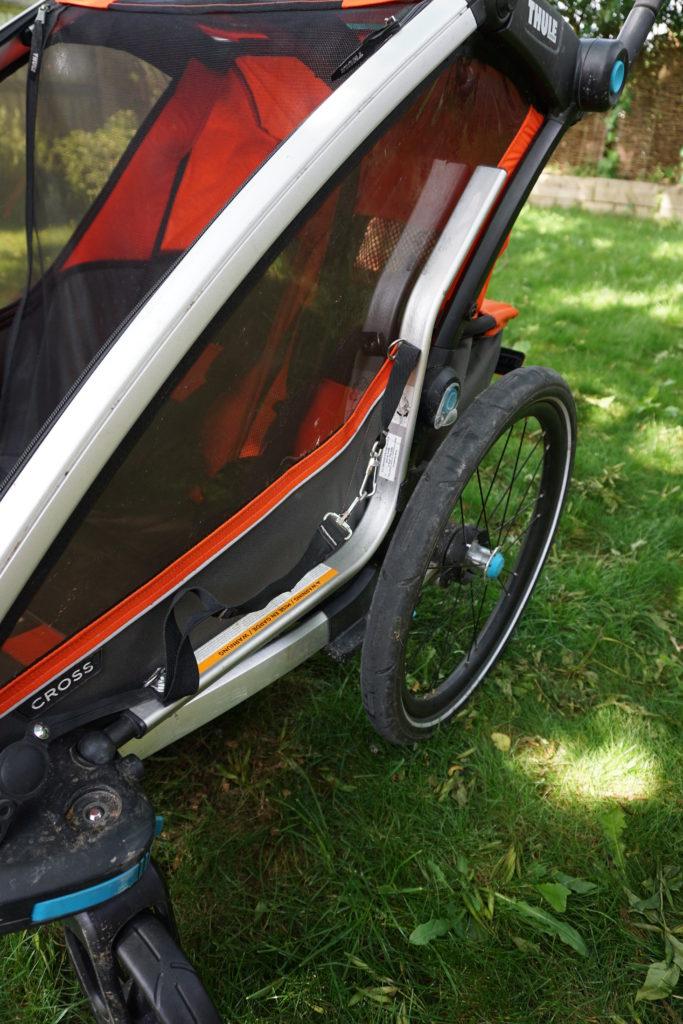
Thule promises that VersaWing ‘enables quick and easy conversion between activities’. I think the switching system is easy to understand, and works well for doing different activities on different days. However, I do run into difficulties when I want to quickly switch modes whilst out and about.
This is mostly down to the difficulties of trying to release and change attachments whilst holding up a trailer full of children, as there are no front wheels in place whilst switching. It’s hard to explain succinctly in words, but if you think that this might be an issue with your intended usage, here is a typical scenario I encounter:
- I cycle to the supermarket with the Cross in Bike mode.
- When I arrive I want to switch to walking mode to do my shopping. I need to remove the bike arm and put in the buggy wheels.
- I can try to slot in the buggy wheels whilst the trailer is still held up by the bicycle, but there isn’t enough room under the VersaWing.
- Instead I detach the Cross from my bike, and the front end tips down to the floor. I have to hold up the Cross and 25kg of children all with one hand (or normally my knee) whilst trying to slot a buggy wheel into the hole underneath, with no visibility.
- Once I have one buggy wheel in it gets a bit easy to put the other in.
- However, the bike arm is still attached. I push the VersaWing release again and yank out the bike arm. This also releases that buggy wheel from underneath, which falls out as I remove the bike arm.
- I again reattach the buggy wheel. Of course, I should have taken the bike arm out before putting in the buggy wheels, but it’s really awkward to find a position where you can hold up the bike trailer, release the VersaWing and pull out the hitch arm all at the same time.
Walking mode
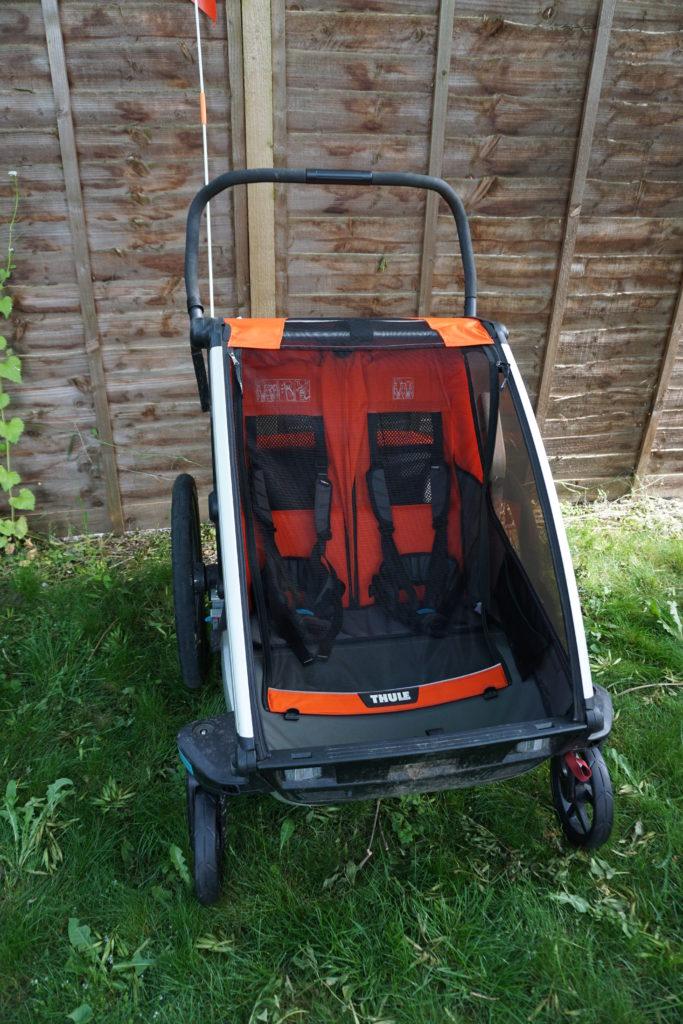
The trailer comes with two small wheels which click in at the front so that you can use it as a buggy. This can be very useful in certain circumstances. For example, cycling to the supermarket, then clicking in the buggy wheels to go shopping. In practice, I don’t think many people would use the double Cross as their standard buggy in the UK, as most shops and pavements aren’t really wide enough to accommodate it. We have occasionally used it in very stormy weather as it offered more protection for the baby, but our normal buggy, a Mountain Buggy Duet is 15cm narrower, and therefore much more practical for daily life. I also find that the buggy wheels on the Cross have a tendency to lock at odd angles, rather like a supermarket trolley.
Jogging mode
You can purchase an additional jogging kit with a single large front wheel. There are two arms which click into the VersaWing on the trailer. The axle of the wheel then slots onto the arms. My husband often jogs with the trailer and thinks the jogging setup works well. We both find that it can be a bit fiddly to get the jogging wheel axle attached to the arms, as you have to hold up the trailer whilst you slot it into place.
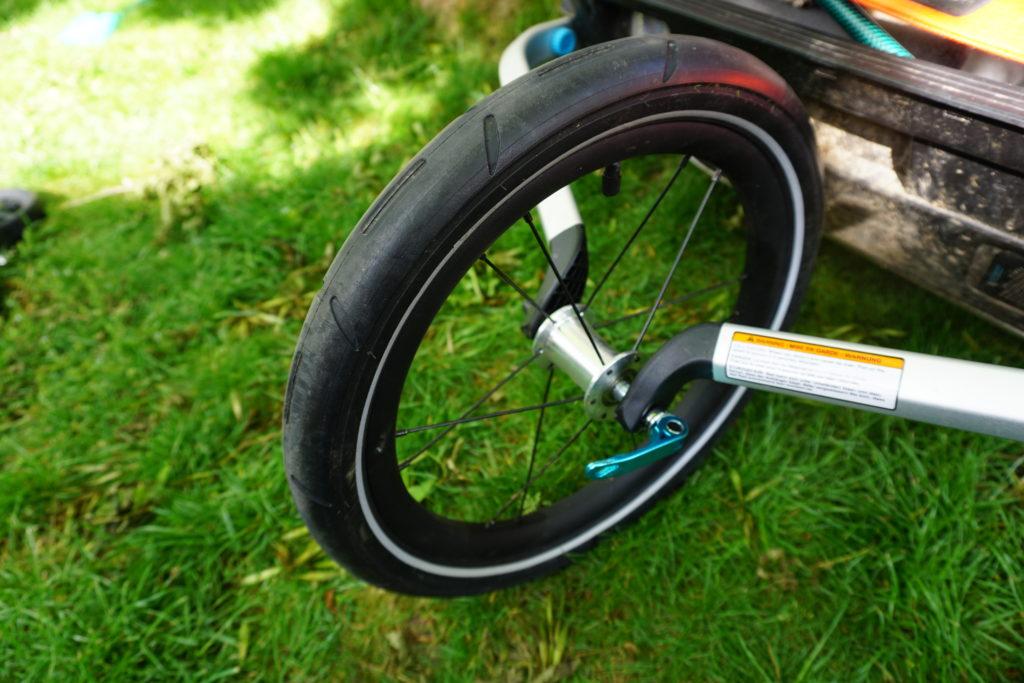
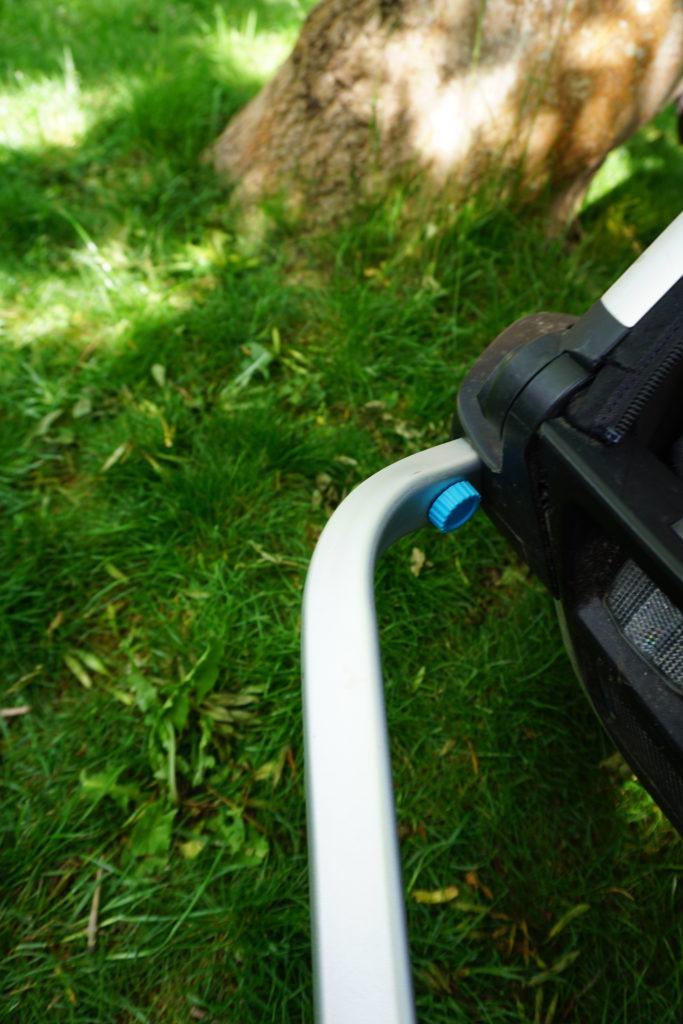
Transporting the Thule Chariot Cross
The two wheels have a quick-release function, and then the trailer itself can be collapsed, making it easy to fit into the boot of a large car. We have transported it like this several times for holidays. The buttons for collapsing it are large and blue, so it is easy to see what to do.
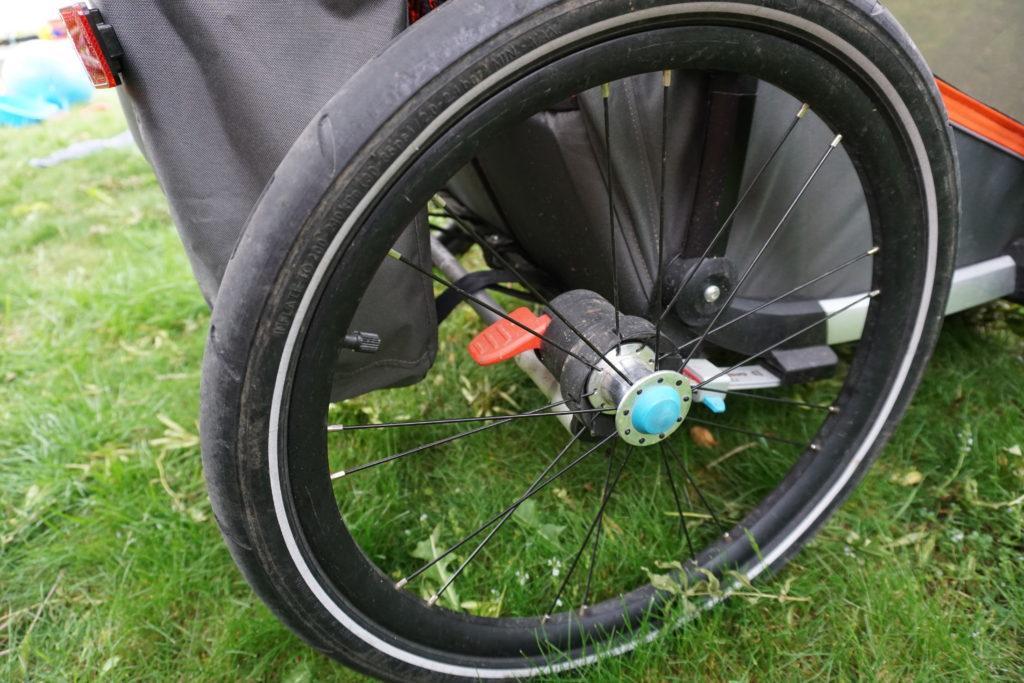
Final Thoughts on the Thule Chariot Cross 2
The Cross is a great bike trailer. It is robust and durable, it handles brilliantly, and has many excellent features for the comfort and safety of its passengers. My favourite features are the individually reclining seats, the infant insert, the sunshade and the ball joint hitch arm.
The areas where it falls down for me are to do with the practicalities of using it daily. I wish it had more reflective panels for cycling in traffic. I would like it to be easier to lock up. I would like the luggage trunk to have a higher weight limit, and for the rain cover to be quicker and easier to use. And I would like to be able to switch between walking and cycling modes more easily whilst out and about. But really, these are all relatively minor things, and they probably wouldn’t be issues at all if you are mostly planning to use it for jogging and leisure cycling.
Where to purchase
There is a list of Thule dealers on their website. You can also purchase the Thule Chariot Cross on Amazon. At the time we purchase ours we found it was significantly cheaper to ship it from Germany from Kindermaxx who run some good sales. It cost less to purchase the trailer, the jogging kit, and to ship it to the UK, than it would have to buy just the trailer here. It arrived smoothly in less than a week.

